| This article needs additional citations for verification. Please help improve this article by adding citations to reliable sources. Unsourced material may be challenged and removed. Find sources: "Zamboanga del Sur" – news · newspapers · books · scholar · JSTOR (July 2014) (Learn how and when to remove this message) |
| Zamboanga del Sur | |
|---|---|
| Province | |
   (from top: left to right) Santa Cruz Island, Pagadian City, and Margosatubig. (from top: left to right) Santa Cruz Island, Pagadian City, and Margosatubig. | |
 Flag Flag Seal Seal | |
| Anthem: Zamboanga del Sur March | |
 Location in the Philippines Location in the Philippines | |
| OpenStreetMap | |
| Coordinates: 7°50′N 123°15′E / 7.83°N 123.25°E / 7.83; 123.25 | |
| Country | Philippines |
| Region | Zamboanga Peninsula |
| Founded |
|
| Capital | Pagadian |
| Largest City | Zamboanga City |
| Government | |
| • Governor | Victor Yu (PDPLBN) |
| • Vice Governor | Roseller Ariosa (PDPLBN) |
| • Legislature | Zamboanga del Sur Provincial Board |
| Area | |
| • Total | 4,499.46 km (1,737.25 sq mi) |
| • Rank | 25th out of 81 |
| (excluding Zamboanga City) | |
| Highest elevation | 1,532 m (5,026 ft) |
| Population | |
| • Total | 1,050,668 |
| • Rank | 26th out of 81 |
| • Density | 230/km (600/sq mi) |
| • Rank | 42nd out of 81 |
| (excluding Zamboanga City) | |
| Demonym | Zambosurians |
| Divisions | |
| • Independent cities |
1
|
| • Component cities | 1 |
| • Municipalities | 26 |
| • Barangays |
|
| • Districts | |
| Time zone | UTC+8 (PHT) |
| ZIP code | 7000–7043 |
| IDD : area code | +63 (0)62 |
| ISO 3166 code | PH-ZAS |
| Spoken languages | |
| Income classification | 1st class |
| Website | www |
Zamboanga del Sur (Cebuano: Habagatang Zamboanga; Subanen: S'helatan Sembwangan/Sembwangan dapit Shelatan; Maguindanaon: Salatan Sambuangan, Jawi: سلاتن سامبواڠن; Filipino: Katimugang Zamboanga), officially the Province of Zamboanga del Sur, is a province in the Philippines located in the Zamboanga Peninsula region in Mindanao. Its capital is the city of Pagadian.
Statistically grouped with Zamboanga del Sur is the highly urbanized City of Zamboanga, which is geographically separated and a chartered city and governed independently from the province and also its largest city.
The province borders Zamboanga del Norte to the north, Zamboanga Sibugay to the west, Misamis Occidental to the northeast, and Lanao del Norte to the east. To the south is the Moro Gulf.
Etymology
The name of Zamboanga is the Hispanicized spelling of the Sinama term for "mooring place" - samboangan (also spelled sambuangan; and in Subanen, sembwangan), from the root word samboang ("mooring pole"). "Samboangan" was the original name of Zamboanga City, from where the name of the peninsula is derived from. "Samboangan" is well-attested in Spanish, British, French, German, and American historical records from as far back as the 17th century.
This is commonly contested by folk etymologies which instead attribute the name of Zamboanga to the Indonesian word jambangan (claimed to mean "place of flowers", but actually means "pot" or "bowl"), usually with claims that all ethnic groups in Zamboanga were "Malays". However, this name has never been attested in any historical records prior to the 1960s.
History
Further information: Zamboanga (province) and Moro Province
.
Early history
The original inhabitants of the Zamboanga Peninsula were the Subanen, who settled along the riverbanks in inland areas; and the various Sama-Bajau and Yakan ethnic groups who settled in coastal areas. Tausūg settlers from northeastern Mindanao also migrated to the region in the 13th century.
The region was additionally settled by migrants (mostly from the Visayas islands) after World War II. Together with the original settlers, these pioneers helped develop Zamboanga del Sur into the abundant and culturally diverse province that it is..
American invasion era
Historically, Zamboanga was the capital of the Moro Province in western Mindanao, which comprised five districts: Cotabato, Davao, Sulu, Lanao, and Zamboanga. In 1940, these districts became individual provinces. Zamboanga City became the capital of Zamboanga province.
Philippine independence
Soon after World War II, the provincial capital was transferred to Dipolog. Molave was created as the provincial capital in 1948.
Foundation
On June 6, 1952, through Republic Act No. 711, Zamboanga del Sur was carved out from the former Zamboanga province that encompassed the entire peninsula in southwestern Mindanao. As the 52nd province of the Philippines, it originally consisted of 11 towns with the City of Zamboanga and the Island of Basilan, which were later expanded into 42 municipalities with the City of Pagadian as the capital.
This happened in the midst of the postwar period, a time when Mindanao was peaceful and increasingly progressive. Ethnic tensions were minimal, and there was essentially no presence of secessionists groups in Mindanao. Tensions in Mindanao mostly began to rise only as the 1970s approached, as a result of social and economic tensions which affected the whole country.
The Marcos era
Main articles: Martial law under Ferdinand Marcos, Ilaga, Jabidah massacre, and Moro conflictThe late 1960s in Mindanao saw a rise in land dispute conflicts arising from the influx of settlers from Luzon and Visayas, and from the Marcos administration’s encouragement of militia groups such as the Ilaga. News of the 1968 Jabidah massacre ignited a furor in the Moro community, and ethnic tensions encouraged with the formation of secessionist movements, starting from the largely political Muslim Independence Movement and Bangsamoro Liberation Organization, and eventually the Moro National Liberation Front (MNLF), and the Moro Islamic Liberation Front (MILF). Additionally, an economic crisis in late 1969, violent crackdowns on student protests in 1970, and 1971, and eventually the declaration of Martial Law all led to the radicalization of many students. Many of them left schools in Manila and joined New People's Army units in their home provinces, bringing the New People's Army rebellion to Mindanao for the first time.
The September 1972 declaration of Martial Law began a 14-year period historically remembered for its human rights abuses, often involving the warrantless detention, murder, and physical, sexual, or mental torture of political opponents, student activists, journalists, religious workers, farmers, and others who fought against the Marcos dictatorship. In Zamboanga del Sur, these were often attributed to military-endorsed Militias, which included the Ilaga and a number of armed cult groups, which were used to enhance the military's numbers as it fought various resisntance movements.
The year 1982 was a particularly bloody year for Zamboanga del Sur under the Marcos dictatorship, as two massacres happened in the province that year. On February 12, 1982, members of the Ilaga killed 12 persons in Dumingag, Zamboanga del Sur, allegedly to avenge the death of their leader, who they believed had been killed by the NPA. And on May 25, 1982, three people were killed and eight people were injured when the administration's airplanes dropped bombs on Barangay Dimalinao of Bayog, Zamboanga del Sur, allegedly as reprisal for the killing of 23 soldiers by supposed rebels two days earlier. Days later, two more men from the community were picked up and killed, and a few months later, the residence of Bayog's Jesuit parish priest was strafed after he had written letters decrying the torture and harassment of the indigenous Subanon people from his parish, whom government had tagged as communist supporters.
Contemporary
Separation of Zamboanga Sibugay
Political developments in February 2001 saw another major change in the territorial jurisdiction of Zamboanga del Sur. Its inhabitants voted to create a new province out of the third congressional district, named Zamboanga Sibugay.
Geography
Zamboanga del Sur covers a total area of 4,499.46 square kilometres (1,737.25 sq mi) occupying the southern section of the Zamboanga peninsula in western Mindanao. It is located at longitude 122° 30"" and latitude 7° 15"" north. When Zamboanga City is included for statistical purposes, the province's land area is 591,416 hectares (5,914.16 km). The province is bordered on the north by Zamboanga del Norte, west by Zamboanga Sibugay, northeast by Misamis Occidental, east by Lanao del Norte, southeast by Illana Bay, and south by the Moro Gulf.
Topography

Stretching northward from Sibugay in the southwest and running along the northern boundary to Salug Valley in the east is the province’s mountainous countryside. The coastal plains extend regularly from south to west then spread into wide flat lands when reaching the coastal plains of the Baganian peninsula in the southeast.
The longest river in Region IX, the Sibugay River gets its water from the mountains of Zamboanga del Sur most specifically in Bayog and Lakewood, from where it flows into Sibuguey Bay which is now part of Zamboanga Sibugay. Other notable rivers are the Kumalarang River, the Dinas River with its headwaters in the Mount Timolan Protected Landscape, and Salug River in Molave.
Climate
The province has a relatively high mean annual rainfall: 1,599 to 3,500 millimetres (63.0 to 137.8 in). Temperature is relatively warm and constant throughout the year: 22 to 35 °C (72 to 95 °F).
| Climate data for Zamboanga del Sur | |||||||||||||
|---|---|---|---|---|---|---|---|---|---|---|---|---|---|
| Month | Jan | Feb | Mar | Apr | May | Jun | Jul | Aug | Sep | Oct | Nov | Dec | Year |
| Mean daily maximum °C (°F) | 30.4 (86.7) |
30.5 (86.9) |
31.6 (88.9) |
32.6 (90.7) |
32.3 (90.1) |
31.7 (89.1) |
31.6 (88.9) |
31.6 (88.9) |
31.8 (89.2) |
31.5 (88.7) |
31.4 (88.5) |
30.8 (87.4) |
31.5 (88.7) |
| Mean daily minimum °C (°F) | 21.8 (71.2) |
21.9 (71.4) |
20.8 (69.4) |
22.2 (72.0) |
21.2 (70.2) |
21.0 (69.8) |
21.1 (70.0) |
21.0 (69.8) |
21.1 (70.0) |
21.3 (70.3) |
21.4 (70.5) |
21.3 (70.3) |
21.3 (70.4) |
| Average rainy days | 15 | 10 | 8 | 7 | 10 | 17 | 16 | 16 | 14 | 16 | 17 | 16 | 162 |
| Source: Storm247 | |||||||||||||
Administrative divisions
Map of Zamboanga del Sur Excluding Zamboanga City
Excluding Zamboanga City Including the highly-urbanized city of Zamboanga for geographical and statistical purposes only
Including the highly-urbanized city of Zamboanga for geographical and statistical purposes only
Zamboanga del Sur comprises 26 municipalities, 1 component city and 1 highly urbanized city organized into two congressional districts and further subdivided into 681 barangays.
Traditionally grouped with Zamboanga del Sur is the highly urbanized city of Zamboanga, which is administratively independent from the province.
- † Provincial capital and component city
- Municipality
- ‡ Highly urbanized city (statistically grouped but independent from the province)
- ∞ Largest settlement
Demographics
|
|
| ||||||||||||||||||||||||||||||||||||||||||||||||||||||
| (excluding Zamboanga City) Source: Philippine Statistics Authority | ||||||||||||||||||||||||||||||||||||||||||||||||||||||||
The population of Zamboanga del Sur in the 2020 census was 1,050,668 people, with a density of 230 inhabitants per square kilometre or 600 inhabitants per square mile. When Zamboanga City is included for statistical purposes, the province's population is 2,027,902 people, with a density of 317/km (820/sq mi).
Religion
Most of the inhabitants in Zamboanga del Sur are Roman Catholics. Other Christian groups are Baptists, Methodists, Aglipayans, Church of Christ of Latter Day Saints, Iglesia ni Cristo, Jehovah's Witnesses, Seventh-day Adventist and other Evangelical Christians. There is a large Muslim minority.
Languages
The most commonly spoken first language in the province is Cebuano, while Chavacano is the majority language in and around Zamboanga City. Filipino and English are also widely used and understood as the national and official language (Filipino) and co-official language (English) of the Philippines, with the former used as a lingua franca for and between various non-local ethnic groups or recent migrants and their families. Minority languages include Maguindanaon, Subanen, Tausug, Maranao, and Iranun as well as Hiligaynon, Ibanag, Ilocano, Kapampangan, Pangasinan and Waray.
Economy
Poverty incidence of Zamboanga del Sur
|
10
20
30
40
2006 31.68 2009 31.61 2012 32.03 2015 25.27 2018 23.68 2021 13.40 Source: Philippine Statistics Authority |


The economy is predominantly agricultural. Products include coco oil, livestock feed milling, rice/corn milling, including the processing of fruits, gifts and housewares made from indigenous materials like handmade paper, roots, rattan, buri, and bamboo; wood-based manufacture of furniture and furniture components from wood, rattan, and bamboo; marine and aquaculture including support services; construction services and manufacture of marble, concrete, and wooden construction materials. There are also mining areas in the province, such as those found in the municipality of Bayog managed by TVI, a Canadian-based mining firm which concentrates on gold mining, and the Cebu Ore Mining which is handling the Ore-Copper-Steel mines. There are also small-scale mines in the municipality of Dumingag.
Government
Vice Governor:
- Roseller L. Ariosa (UNA)
Representatives:
- 1st District - Divina Grace C. Yu (PDP-Laban)
- 2nd District - Leonardo L. Babasa Jr. (PDP-Laban)
|
Notable people
Within the province jurisdiction
- Felip Jhon Suson a.k.a. Ken - member of Filipino pop boy band, SB19 (Lakewood)
- Antonio Cerilles - former Secretary of the Department of Environment and Natural Resources (DENR) during the term of President Joseph Estrada; (from 1998 to 2001); Governor of Zamboanga del Sur from 2010 to 2019 (Pagadian)
- Mateo Olivar - Catholic church worker of the Diocese of Pagadian assassinated during the Marcos dictatorship and one of the first to be formally acknowledged as a martyr of the religious sector's resistance against the Marcos dictatorship at the Philippines’ Bantayog ng mga Bayani (Pagadian)
- Enrique Ona - former Secretary of Health (2010 - December 19, 2014); former executive director of the National Kidney and Transplant Institute (Pagadian)
- Francese Therese Pinlac - is a member of MNL48's Team L. She was also a member of TGC Senbatsu before being promoted as an official member of MNL48, the official sister group of the highest-selling JPOP phenomenon, AKB48 (Pagadian)
- Divina Grace Yu - current 1st district Representative of Zamboanga del Sur, and former vice mayor of Pagadian (Pagadian)
- Victor Yu - current Governor of Zamboanga del Sur from 2019–present (Pagadian)
Outside the province jurisdiction (highly-urbanized city of Zamboanga)
Main pages: Category:People from Zamboanga City and Zamboanga City § Notable personalitiesReferences
- "List of Provinces". PSGC Interactive. Makati City, Philippines: National Statistical Coordination Board. Archived from the original on May 18, 2001. Retrieved 16 July 2014.
- ^ Census of Population (2020). "Region IX (Zamboanga Peninsula)". Total Population by Province, City, Municipality and Barangay. Philippine Statistics Authority. Retrieved 8 July 2021.
- Rodney C. Jubilado; Hanafi Hussin & Maria Khristina Manueli (2011). "The Sama-Bajaus of Sulu-Sulawesi Seas: perspectives from linguistics and culture" (PDF). JATI - Journal of Southeast Asian Studies. 15 (1): 83–95.
- ^ Francisco Combes (1667). Historia de las islas de Mindanao, Iolo y sus Adyacentes. Progresos de la Religion y Armas Catolicas. Pablo del Val.
- Challenger Expedition 1872-1876 (1895). Report on the Scientific Results of the Voyage of H.M.S. Challenger During the Years 1873-76 Under the Command of Captain George S. Nares ... and the Late Captain Frank Tourle Thomson, R.N. H.M. Stationery Office. p. 823–828.
{{cite book}}: CS1 maint: numeric names: authors list (link) - George Newenham Wright (1837). A New and Comprehensive Gazetteer, Volume 4. T. Kelly. p. 459.
- Antoine-François Prévost (1757). Histoire générale des voyages ou Nouvelle collection de toutes les relations de voyages par mer et par terre, qui ont été publiées jusqu'à présent dans les differentes langues de toutes les nations connues. De Hondt. p. 37.
- Pierre Joseph André Roubaud (1770). Histoire générale de l'Asie, de l'Afrique et de l'Amérique. Des Ventes de la Doué. p. 499–500.
Samboangan.
- John Meares (1791). Des Kapitians John Meares und des Kapitains William Douglas Reisen nach der Nordwest-Küste von Amerika, in den Jahren 1786 bis 1789. Voß. p. 240.
- Charles Pickering (1848). "The Races of Man and their Geographical Distribution". United States Exploring Expedition. During the Years 1838, 1839, 1840, 1841, 1842. Under the Command of Charles Wilkes, USN. Volume IX (PDF). C. Sherman. p. 125.
- Enriquez, A.R. "Jambangan: the "Garden of Flowers" never was!". Antoniofermin's Name. Retrieved 13 September 2016.
- Alfred Kemp Pallasen (1985). Culture Contact and Language Convergence (PDF). LSP Special Monograph Issue 24. Linguistic Society of the Philippines.
- Tom Gunnar Hoogervorst (2012). "Ethnicity and aquatic lifestyles: exploring Southeast Asia's past and present seascapes" (PDF). Water History. 4 (3): 245–265. doi:10.1007/s12685-012-0060-0. S2CID 53668253.
- Rodney C. Jubilado (2010). "On cultural fluidity: The Sama-Bajau of the Sulu-Sulawesi Seas". Kunapipi. 32 (1): 89–101.
- Wernstedt, Frederick L.; Simkins, Paul D. (1965). "Migrations and the Settlement of Mindanao". The Journal of Asian Studies. 25 (1): 83–103. doi:10.2307/2051042. JSTOR 2051042. S2CID 161928753.
- "Republic Act No. 711 - An Act to Create the Provinces of Zamboanga del Norte and Zamboanga del Sur". Chan Robles Virtual Law Library. Retrieved 28 September 2013.
- ^ Miclat, Gus (2002). "Our lives were never the same again". In Arguillas, Carolyn O. (ed.). Turning rage into courage : Mindanao under martial law. MindaNews Publications, Mindanao News and Information Cooperative Center. OCLC 644320116.
- ^ The Bangsamoro Struggle for Self-Determintation: A Case Study
- ^ Colin Mackerras; Foundation Professor in the School of Asian and International Studies Colin Mackerras (2 September 2003). Ethnicity in Asia. Routledge. pp. 143–. ISBN 978-1-134-51517-2.
- ^ Rodis, Rodel (2015-01-30). "Remembering the First Quarter Storm". INQUIRER.net. Retrieved 2020-09-15.
- See "History of the Philippines: From Indios Bravos to Filipinos" By Luis H. Francia| Link to page in the referenced book
- For an in-depth survey of indigenous peoples and forced land seizures in the Philippines, see Cultural Survival Quarterly.
- George, T. J. S. (1980). Revolt in Mindanao : the rise of Islam in Philippine politics. Kuala Lumpur. ISBN 0-19-580429-5. OCLC 6569089.
{{cite book}}: CS1 maint: location missing publisher (link) - "Alfred McCoy, Dark Legacy: Human rights under the Marcos regime". Ateneo de Manila University. September 20, 1999.
- Abinales, P.N.; Amoroso, Donna J. (2005). State and society in the Philippines. Lanham, MD: Rowman & Littlefield Publishers. ISBN 978-0742510234. OCLC 57452454.
- "Gone too soon: 7 youth leaders killed under Martial Law". Rappler. Retrieved June 15, 2018.
- Rachman, Arpan (2 December 2014). "Private Armed Militias Worsen Impunity". Retrieved 11 May 2016.
- The Philippines: Violations of the Laws of War by Both Sides. Human Rights Watch. 1990. p. 41. ISBN 0929692527.
Civilian Home Defense Forces.
- Doyo, Ma. Ceres P. "Martial law massacres". Retrieved 2018-06-18.
- Pumipiglas: Political Detention and Military Atrocities in the Philippines, 1981-1982. Task Force Detainees of the Philippines, Association of Major Religious Superiors in the Philippines. 1986.
- "Republic Act No. 8973; An Act Creating the Province of Zamboanga Sibugay from the Province of Zamboanga del Sur and for Other Purposes" (PDF). House of Representatives of the Philippines. Retrieved 13 January 2016.
- ^ "Province: Zamboanga del Sur". PSGC Interactive. Quezon City, Philippines: Philippine Statistics Authority. Retrieved 8 January 2016.
- "Weather forecast for Zamboanga del Sur, Philippines". Storm247. Retrieved 20 April 2016.
- ^ Census of Population (2015). "Region IX (Zamboanga Peninsula)". Total Population by Province, City, Municipality and Barangay. Philippine Statistics Authority. Retrieved 20 June 2016.
- ^ Census of Population and Housing (2010). "Region IX (Zamboanga Peninsula)" (PDF). Total Population by Province, City, Municipality and Barangay. National Statistics Office. Retrieved 29 June 2016.
- "Poverty incidence (PI):". Philippine Statistics Authority. Retrieved December 28, 2020.
- "Estimation of Local Poverty in the Philippines" (PDF). Philippine Statistics Authority. 29 November 2005.
- "2009 Official Poverty Statistics of the Philippines" (PDF). Philippine Statistics Authority. 8 February 2011.
- "Annual Per Capita Poverty Threshold, Poverty Incidence and Magnitude of Poor Population, by Region and Province: 1991, 2006, 2009, 2012 and 2015". Philippine Statistics Authority. 27 August 2016.
- "Annual Per Capita Poverty Threshold, Poverty Incidence and Magnitude of Poor Population, by Region and Province: 1991, 2006, 2009, 2012 and 2015". Philippine Statistics Authority. 27 August 2016.
- "Annual Per Capita Poverty Threshold, Poverty Incidence and Magnitude of Poor Population, by Region and Province: 1991, 2006, 2009, 2012 and 2015". Philippine Statistics Authority. 27 August 2016.
- "Updated Annual Per Capita Poverty Threshold, Poverty Incidence and Magnitude of Poor Population with Measures of Precision, by Region and Province: 2015 and 2018". Philippine Statistics Authority. 4 June 2020.
- "2021 Full Year Official Poverty Statistics of the Philippines" (PDF). Philippine Statistics Authority. 15 August 2022. Retrieved 28 April 2024.
- "UCA News". Union of Catholic Asian News. 1998-11-26. Archived from the original on 2023-10-04. Retrieved 2023-10-04.
- "Martyrs and Heroes: Mateo Olivar". Bantayog ng mga Bayani website. 2023-06-20. Archived from the original on 2023-10-04. Retrieved 2023-10-04.
External links
Map all coordinates using OpenStreetMapDownload coordinates as:
 Media related to Zamboanga del Sur at Wikimedia Commons
Media related to Zamboanga del Sur at Wikimedia Commons Geographic data related to Zamboanga del Sur at OpenStreetMap
Geographic data related to Zamboanga del Sur at OpenStreetMap- Official website of Zamboanga del Sur
- Daily Zamboanga Times
| Places adjacent to Zamboanga del Sur | ||||||||||||||||
|---|---|---|---|---|---|---|---|---|---|---|---|---|---|---|---|---|
| ||||||||||||||||
| Pagadian (capital) Zamboanga City (largest city) | |
| Municipalities | |
| Component city | |
| Highly urbanized city |
|
